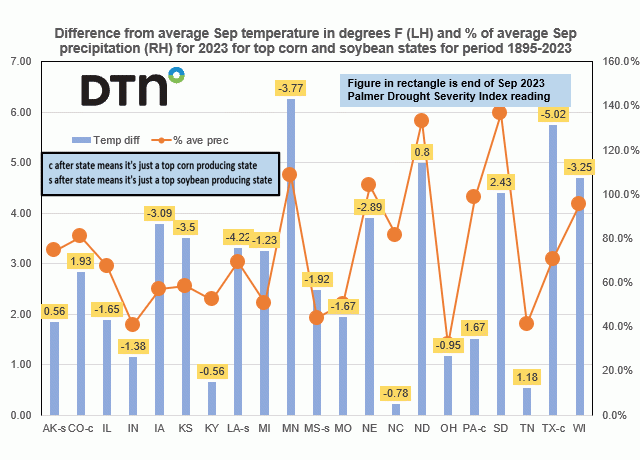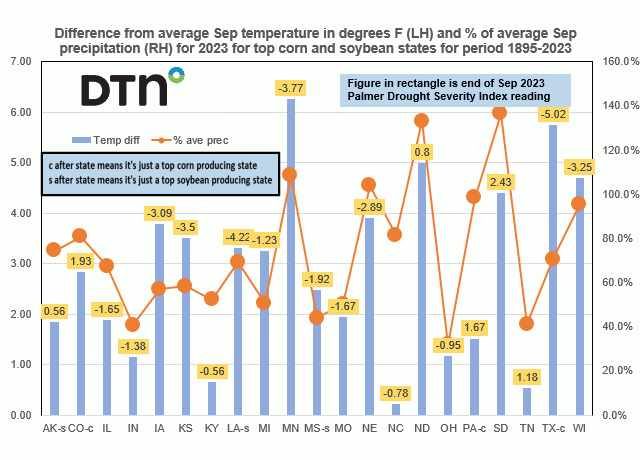Fundamentally Speaking
Warm, Dry September for Corn, Bean States
A month ago, there was talk of a corn yield down near 170-171 bushels per acre (bpa) and bean yields of 49.0-49.5 bpa, linked to a very dry six-week period from 2nd week of August all the way through September spurring ideas of lower corn ear weights and smaller soybean pod sizes.
Apparently, what are better than expected harvest results reported so far has changed sentiment somewhat as trade not looking for much change from USDA September figures as both corn and beans yields are seen down 0.1 bpa for each at 173.7 bpa and 50.0 bpa respectively, resulting in a mere 21 million bushel (mb) drop in production for corn and just 11 mb for soybeans.
Nonetheless, the just released NOAA state of the U.S. Climate report shows September 2023 was the seventh-warmest September on record for the nation, and precipitation ranked in the driest third of the historical record for the month.
Near-record to record-warm temperatures were observed across much of the Southern Plains and Upper Midwest for September. Texas ranked warmest on record for September while Minnesota ranked second warmest, while an additional 10 states ranked among their top-ten warmest Septembers on record.
Meanwhile, precipitation was below average across much of the Mississippi Valley, Great Lakes and Ohio and Tennessee valleys as well as in parts of the Southwest, Southern Plains and Southeast.
P[L1] D[0x0] M[300x250] OOP[F] ADUNIT[] T[]
Precipitation was above average across much of the West and Northern Plains.
On the dry side, Ohio ranked fifth driest on record for the month with two additional states ranking among their top-ten driest Septembers on record.
Along these lines, this chart shows the difference from the average September temperature in degrees Fahrenheit on the left-hand axis while the percent of the average September precipitation is reported on the right-hand axis.
This is for the top 21 corn and soybean producing states, with 15 producing both, and covers the period 1895-2023.
Also plotted in the rectangles is the end of September 2023 Palmer Drought Severity Index that indicates the severity of a wet or dry spell.
The index generally ranges from -6 to +6, with negative values denoting dry spells and positive values indicating wet spells.
In a number of blog pieces this summer we noted that the more northern and southern corn and soybean producing states were the ones most subject to above average temperatures and below average rains.
For temperatures, this trend continued last month as all 21 states had above average readings with Minnesota 6.26 degrees above average as they had their second hottest September ever.
Texas came in at 5.75 degrees above average and had their hottest September ever going back to 1895.
Louisiana, the Dakotas, and Wisconsin saw September temperatures at least 4.40 degrees above average.
As for precipitation, only MN, NE, ND and SD saw September 2023 rainfall above average, but Minnesota with an end of Sep PDSI reading of -3.77 and Nebraska with a reading of -2.89 still have very serious drought conditions as do Iowa, Louisiana, Texas and Wisconsin.
Note that at least 13 of the 21 states had September rainfall 70% or less of normal.
(c) Copyright 2023 DTN, LLC. All rights reserved.






Comments
To comment, please Log In or Join our Community .